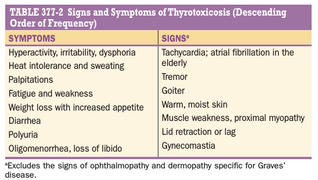As in autoimmune hypothyroidism, a combina- tion of environmental and genetic factors, including polymorphisms in HLA-DR, the immunoregulatory genes CTLA-4, CD25, PTPN22, FCRL3, and CD226, as well as the gene encoding the thyroid- stimulating hormone receptor (TSH-R), contributes to Graves’ disease susceptibility. The concordance for Graves’ disease in monozygotic twins is 20–30%, compared to <% in dizygotic twins. Indirect evidence suggests that stress is an important environmental factor, presumably operating through neuroendocrine effects on the immune system. Smoking is a minor risk factor for Graves’ disease and a major risk fac- tor for the development of ophthalmopathy. Sudden increases in iodine intake may precipitate Graves’ disease, and there is a threefold increase in the occurrence of Graves’ disease in the postpartum period. Graves’ disease may occur during the immune reconstitution phase after highly active antiretroviral therapy (HAART) or alemtuzumab treatment. The hyperthyroidism of Graves’ disease is caused by thyroid- stimulating immunoglobulin (TSI) that are synthesized in the thyroid gland as well as in bone marrow and lymph nodes. Such antibodies can be detected by bioassays or by using the more widely available thyrotropin-binding inhibitory immunoglobulin (TBII) assays. The presence of TBII in a patient with thyrotoxicosis implies the existence of TSI, and these assays are useful in monitoring pregnant Graves’ patients in whom high levels of TSI can cross the placenta and cause neonatal thyrotoxicosis. Other thyroid autoimmune responses, similar to those in autoimmune hypothyroidism (see above), occur concur- rently in patients with Graves’ disease. In particular, thyroid peroxi- dase (TPO) and thyroglobulin (Tg) antibodies occur in up to 80% of cases. Because the coexisting thyroiditis can also affect thyroid func- tion, there is no direct correlation between the level of TSI and thyroid hormone levels in Graves’ disease. Cytokines appear to play a major role in thyroid-associated ophthal- mopathy. There is infiltration of the extraocular muscles by activated T cells; the release of cytokines such as interferon γ (IFN-γ), tumor necrosis factor (TNF), and interleukin-1 (IL-1) results in fibroblast acti- vation and increased synthesis of glycosaminoglycans that trap water, thereby leading to characteristic muscle swelling. Late in the disease, there is irreversible fibrosis of the muscles. Though the pathogenesis of thyroid-associated ophthalmopathy remains unclear, there is mounting evidence that the TSH-R is a shared autoantigen that is expressed in the orbit; this would explain the close association with autoimmune thy- roid disease. Increased fat is an additional cause of retrobulbar tissue expansion. The increase in intraorbital pressure can lead to proptosis, diplopia, and optic neuropathy.
